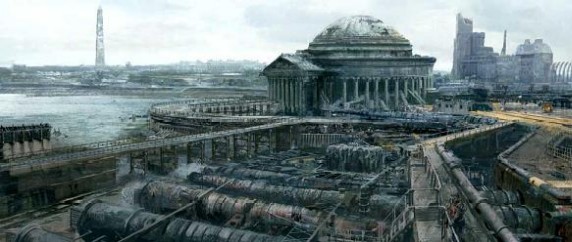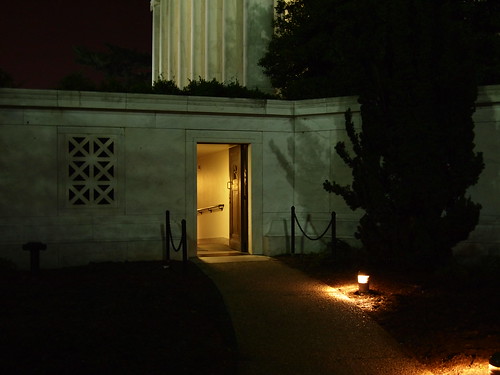“The best place to view Los Angeles of the next millennium is from the ruins of its alternative future” thus Mike Davies begins his provocative history of L.A. When Davies interrogates Blade Runner and The Martian Chronicles he finds a considerable amount of material to critically interpret the city and the idea of the west itself. I’m not sure that we can find that kind of depth for understanding DC in Fallout 3. I do, however, think it effects us on a deeper affective level. It feels less like a specific critique of society and more of a heady mixture of 50s nostalgia and unsettling paranoia.
When I started writing my post about historical thinking in Fallout 3 last month, I quickly realized that there were two very different things I wanted to comment on. First, there is the way that you understand the past of the gameworld, which I wrote about. But I kicked the second part down the road for this post. Aside from the role the past plays in the game, there is a funny way that the games depicted future plays games with our lived experience.
Feeling Uneasy in DC
You might need to live in DC for this to have effected you, but the several gamers who live in the area have reported a funny kind of feeling after playing the game. Several friends have told me that the game tends to make you see the real world a little different, at least for a while. One friend talked about how he felt a strange urgency to stay off main through-ways around the city. Another mentioned a funny kind of uneasiness when going down into metro stations. Almost all of them have tried to plot where their house would be on the game map. The fact that the game happens in a vision of the place we live our lives makes the game a lens we use to see and experience that city in a different light.

It is as if the experience of the game does not just wash off. The visual anchors of DC, the Washington Memorial, the Federal style architecture, the metro stations, the remnants of the retro-futuristic Smithsonian institution stick with you. It is an augmented reality game that plays out after the fact. A set of visual information that your mind layers onto the physical environment long after you have turned off the game.
Visiting Project Purity, Um.. I mean the Jefferson Memorial
The game gives you a kind of prosthetic memory. Earlier this year a few good fvisited to participate in the Rally4Sanity. The following day we had a bit of time before I needed to drop them off at the Airport, so we decided to make a stop at the Jefferson Memorial. As the memorial came in sight, both my cousin and my friend made statements like “Oh, right Project purity!.” Both had been Fallout 3 players, and both had the salience of that moment in their minds when they first took in the monument.
The Jefferson Memorial had been designed to give a particular impression of Jefferson. The experience of the monument entangles with our memories of fictional events from the wasteland. As we walked up to the door to the gift shop my cousin made jokes about swapping out for some heavier armor, and we collectively reminisced about a few of the times the game sent you back into the memorial through the gift shop to clear it out again.
This might seem trivial, but when we remember that monuments have rhetoric’s, that they are created to make arguments, the power this game had to change our experience of the monument is significant. As Sanford Levinson reminds us, the arguments of monuments and memorials are Written in Stone. We experienced the monument, to some extent, mediated through our memories of the wastes.
Seeing the City through Fallout
Lest you think these are simply the peculiarities of me and my strange friends, I offer you these images from flicker. This is just a sampling of the ways people are using the game to filter their experience.

I would suggest that this image is filtered twice over. That it is filtered both explicitly and implicitly. When yarnzombie put the image filter on this photo they did more than apply a photo effect. They actually used Fallout 3 as a kind of filter to interpret the Jefferson Memorial.

It’s Fallout 3, did not even require the first kind of filter. This view is exactly the same view that grabbed me and my friends when we visited the memorial. Fallout primes you to experience the entry way into the visitors center as the most salient part of the experience. This is where you as the player stop to check your inventory of stem-packs, try to make some quick repairs to the armor you scavenged off some raiders, and double check your ammo before you skulk in to take down the super mutants who have laid claim to the Project Purity housed in the former Jefferson Memorial. The fact that a game can, to some extent, overwrite part of the story of America embedded in this monument is fascinating.
Does it stick with you?
Are their other moments in Fallout, or for that mater in other games which have stuck with you and changed how you see the world? Does the way a game like Fallout engages us make this work differently than other media, like books and film, or do we think this is a generic property of various modes of storytelling?

Great article. As someone currently playing through Fallout 3 I love thinking about these posts while running through the post-apocalyptic wastelands.
I’ve often wondered about this augmenting reality effect of gaming, especially from driving video games. Recently there was a truck blown off the road into the other lane, and a driver claimed that he was able to avoid the oncoming truck due to his years of video gaming. (http://www.gamepron.com/news/2011/01/24/driver-claims-video-game-reflexes-saved-his-life/). I’ve noticed playing laser tag or paintball I fall to the same tactics as those I employ in Halo 3. However, I think what is occurring to players who see the world differently after gaming is not this reflex based reaction due to the underlying mechanics of the game, but a reaction to the story and visual imagery. As you mentioned, one individual did say that Fallout 3 made him not want to travel on main roads, a leftover from the more strategic and underlying game mechanisms. However, the I think that games like this (as well as numerous sci-fi books over the years) show us a possibility. I recently read the book Ubik by Robert Heinlein, a potential future where people live beyond death in their subconscious and can continue to be contacted by the living. In the beginning, one of the characters laments on the brutality of cremation in the past which destroyed this subconscious, but that science needed to improve before humans could realize that fact. Stories like this make us question our reality, and function in the same way Fallout 3 does. I think the real question is, how can we use these post-gaming effects in order to create real change? Are games like Fallout 3 accomplishing anything in warning us of what potential futures, or is it just a shadow of an intense experience that will wear off?
Looking forward to more posts!
Thanks for those examples I think they are quite useful for helping to better understand what things in games stick with us and the extent to which those things are the same and different from other media.
In reference to the driving comments. I have seen some hard core full blown experimental psych studies that suggest that playing twitch fps games enables players to increase the number of objects they can simultaneously track with their eyes. Similarly, playing extended bouts of strategy games like Civ in those experimental settings has been shown to up performance of random groups of folks on some stock measures that are supposed to provide more or less consistent measures of a few constructs related to analysis. In these cases, I think there is something to be said about the immersiveness of the games sticking with you at that sort-of “twitch” level.
Now, I can speak to experiences of how I’ve used books, films, television shows as ways to interpret my own life and experience. In this sense I think all of these media have the same potential to act as a lenses. So if my friends and I had watched Fallout the movie I think we might have had the same kind of Project Purity/Jefferson Memorial experience. With that said, the fact that I spent 67 hours running around the wastes means that even on that sort of narrative level I just soaked it in for far longer than a film or a book.
I feel like there is something between this sort of lens experience and the twitch thing too. Some of the ways people described their experiences with DC after playing the game have that visceral level, feelings of paranoia, unease at the metro stop. It is a bit of the twitch response mixed up with specific narrative hooks.
“The Go Game confirmed a lot of what I suspected and tried to deliver in the Beast,” Lee said, “which is that the best games make you more suspicious of, more attentive to, the world around you. They make you seek out the pieces of something you’re already a part of. But first they must make you a part of it.”
ARG designer Elan Lee, quoted in Jane McGonigal’s “A Real Little Game”
http://janemcgonigal.files.wordpress.com/2010/12/mcgonigal-a-real-little-game-digra-2003.pdf
Wow – this is a great and well thought out article. It resonates with me totally – not because I live in DC (Although I have been there a number of times and I totally get the “Hey, Fallout 3!” response.)
It resonates because very often when I am wandering and looking around in Ottawa or Toronto or as I drive along on ramps, highways, near highways, next to the Burlington Skyway, I very often have an eerie deja vu of the Fallout kind – where I can briefly see what that particular location would be like to the post-apocalyptic adventurer.
Try heading through downtown Montreal with their decaying infrastructure of sky-high bridges and not feel the eerie overlay of Fallout coming through.